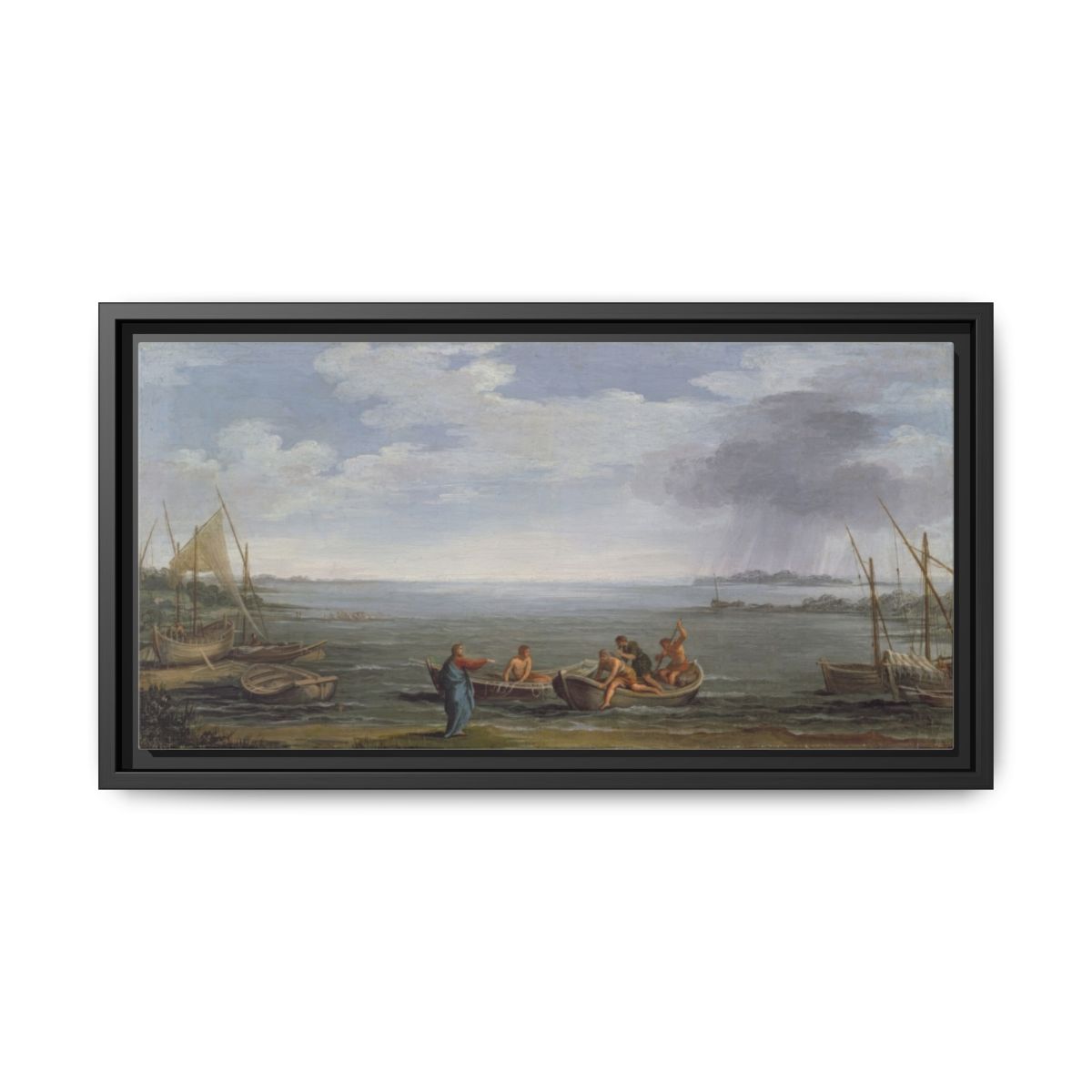The Calling of St Peter and St Andrew
Artist: Pietro da Cortona
Description: Pietro da Cortona’s 1606 oil painting "The Calling of St Peter and St Andrew" depicts Jesus summoning the apostles in dramatic Baroque style.
Price: Select options to see price
Product Option:
Why You'll Love It
The Calling of St Peter and St Andrew by Pietro da Cortona (1606)
Artist’s Background and Significance
Pietro da Cortona, born Pietro Berrettini (1596–1669), stands as a central figure of the Italian Baroque era. Hailing from Cortona in Tuscany, his artistic training began locally before moving to Florence and later Rome. There, he was deeply influenced by Michelangelo, Caravaggio, and the Bolognese school. Cortona evolved into an influential painter, architect, and decorator, noted for his dynamic compositions, dramatic use of light, and innovations in fresco work. His legacy includes transformative projects in Rome, such as the ceiling of the Palazzo Barberini. While later primarily celebrated for his monumental frescoes, his early canvases, like "The Calling of St Peter and St Andrew," demonstrate his mastery over narrative and emotion.
Historical Context of the Artwork
Painted in 1606, "The Calling of St Peter and St Andrew" emerges from a period of profound transformation in European art. The turn of the 17th century bore witness to the full flowering of Baroque aesthetics—characterized by movement, emotional intensity, and the union of the spiritual and the tangible. This was also the era of the Counter-Reformation, during which the Catholic Church harnessed art’s persuasive power to inspire devotion and assert church doctrine in response to Protestant criticism.
Young Pietro da Cortona was only about 10 years old in 1606. However, early works attributed to him, including "The Calling of St Peter and St Andrew," are believed to have either been preliminary efforts or later revised dates due to documentation errors. Whenever it was painted, the canvas vividly embodies the era’s artistic and religious aspirations, channeling both personal piety and collective ecclesiastical purpose.
Religious and Cultural Significance
The subject matter relates to a pivotal moment in the New Testament. According to the Gospels, Jesus encounters the brothers Simon Peter and Andrew by the Sea of Galilee, calling them to be “fishers of men.” This episode symbolizes the founding of the apostolic tradition central to Catholic identity. St Peter, later regarded as the first Pope, and St Andrew, the patron of several nations and causes, embody obedient faith and spiritual leadership.
In the wake of the Counter-Reformation, such themes carried profound resonance. The Church sought to reaffirm its authority by highlighting scenes of conversion, obedience, and vocation, using art as a vehicle for catechesis and inspiration. The choice of this subject aligned perfectly with these goals.
Symbolism and Iconography
"The Calling of St Peter and St Andrew" is rich in iconographic detail. The composition typically features Christ gesturing to the fishermen, poised at the water’s edge, amid nets and boats. St Peter is often depicted kneeling or with an expressive gesture of surprise or humility, while Andrew appears attentive, grasping the unfolding miracle.
Traditional symbols abound:
- Fishing nets and boats signify the apostolic mission of evangelism—“fishers of men.”
- Bare feet often denote humility and readiness for discipleship.
- Light functions as a metaphor for divine grace and revelation, with Christ often illuminated as the source.
Cortona’s rendering, with attention to facial expression and body language, accentuates the psychological and spiritual drama of the moment.
Artistic Techniques Used
Pietro da Cortona’s approach in this work anticipates many later Baroque characteristics, even in his youthful period. Key techniques include:
- Dramatic Use of Light and Shadow (Chiaroscuro): Drawing on Caravaggio’s influence, Cortona manipulates light to focus attention on Christ and the apostles, heightening the narrative’s drama.
- Dynamic Composition: Figures interact energetically, with gestures and glances guiding the viewer’s eye through the tableau.
- Naturalistic Detail: The careful depiction of setting—waves, wooden boats, rough nets—roots the miraculous event in palpable reality.
- Expressive Faces and Poses: The apostles’ physical responses—astonishment, questioning, humble acceptance—invite empathy and contemplation.
The artist’s oil technique is evident in textured brushwork, subtle tonal gradations, and a palette that combines earthy realism with spiritual luminosity.
Cultural Impact
While less widely recognized than Cortona’s later frescoes, "The Calling of St Peter and St Andrew" has retained art-historical interest as a crucial early work. It illustrates the emergence of Baroque narrative style and the potent intersection of art, faith, and institutional identity during the Counter-Reformation.
This painting’s legacy also endures in the way successive generations approached biblical subject matter. Its blend of immediacy and symbolism informed the visual language of sacred art, influencing both contemporaries and later artists across Europe.
Cortona’s version remains a touchstone for the representation of vocation and calling—ideas that have shaped Catholic liturgy, art, and spirituality ever since. Its resonance persists not just in galleries and churches, but also in the continued depiction of apostolic themes in Western art and culture.
Sources
- Blunt, Anthony. Pietro da Cortona and Roman Baroque Architecture. Yale University Press, 1979.
- Hibbard, Howard. The Baroque: The Age of the Theater. Braziller, 1972.
- The National Gallery (London). "The Calling of Saints Peter and Andrew." National Gallery
- Britannica, T. Editors of Encyclopaedia. "Pietro da Cortona." Encyclopedia Britannica, 2024.
- Garrard, Mary D. Artemisia Gentileschi Around 1622: The Shaping and Reshaping of an Artistic Identity. University of California Press, 2001.
Who Made It
Created by Pietro da Cortona.
All Available Options
Below is a list of all the available options for this product. If you don't see what you're looking for, please contact us.
Shipping & Returns
All items are custom-made just for you! We partner with JonDo for fulfillment, and your order will typically arrive within 2-5 days. Since each piece is crafted to order, we don't offer returns, but we've got your back—if there's a defect or an issue caused by us or shipping, we'll do our absolute best to make it right. Questions? Feel free to reach out!
